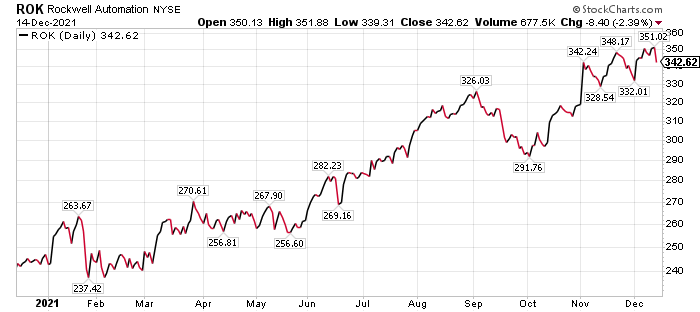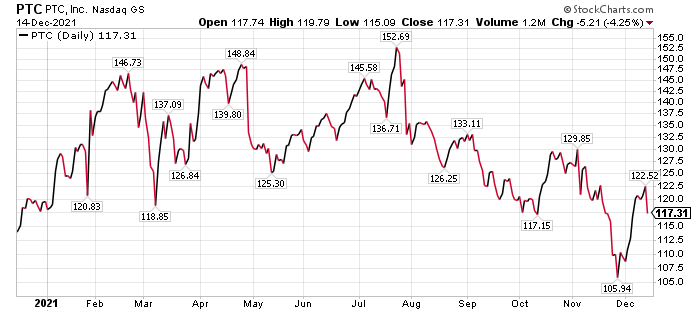Five industrial automation stocks to buy in response to wage inflation are outperforming their peers amid labor shortages caused by COVID-19.
Rising wages and reduced availability of workers are spurring companies to increase industrial automation spending. The trend that is occurring with the five industrial automation stocks to buy became apparent even before the coronavirus, as labor productivity slowed in both the United States and other developed nations.
With U.S. manufacturing wages now rising at the fastest pace since 1982, it gives companies reason to invest in automation. With the offshoring of manufacturing and the globalization of supply chains facing new headwinds, alternatives to automation investments are waning.
“Executive surveys, conference call transcripts and industrial robot sales all show rising interest in automation,” according to a recent research note from Bank of America Global Research.
Five Industrial Automation Stocks to Buy Outperform Their Peers
These industrial stocks are outperforming their peers by using artificial intelligence, cloud computing, software and automation.
Investors looking for a diversified position in industrial stocks could choose an exchange-traded fund (ETF), but they would need to tolerate the “sometimes-puzzling classification” of certain companies as industrials, said Bob Carlson, who serves as chairman of a pension fund and the head of the Retirement Watch investment newsletter. A broad-based fund that Carlson said he likes right now is iShares Global Industrials (EXI), an ETF that seeks to track the S&P Global 1200 Industrial Index.
The fund holds 202 stocks and has 21% of its holdings in the 10 largest positions. The top holdings are Union Pacific Corporation (NYSE: UNP), United Parcel Service, Inc. (NYSE: UPS), Honeywell International Inc. (NASDAQ: HON), Siemens AG (OTCMKTS: SIEGY) and Raytheon Technologies Corporation (NYSE: RTX).
Recently, about 53% of the fund was invested in U.S.-based companies and the other 47% in non-U.S. companies. The fund is up 14.85% for the year to date and is down 1.26% over the last three months.

Pension fund and Retirement Watch chief Bob Carlson answers questions from columnist Paul Dykewicz.
Five Industrial Automation Stocks to Buy Feature Honeywell
Honeywell International, Inc., a Charlotte, North Carolina-based provider of aerospace and building technologies, performance materials and technologies, as well as safety and productivity solutions, gained a buy recommendation from BoA. The diversified global industrial technology company has several business segments using enhanced automation and productivity offerings, according to BofA.
Process automation, estimated to produce $4.6 billion in 2021 revenue, has been the company’s historic area of strength, BofA wrote. Honeywell’s oil & gas mix composes 40-45% of the sub-segment.
In the past five years, Honeywell has established a strong presence in warehouse automation, which BofA estimates will total $3.2 billion in 2021. Honeywell has invested in organically developing software platforms across its markets under the Honeywell Forge brand, complementing existing hardware positions.

Chart courtesy of www.stockcharts.com
BofA Chooses Top Five Industrial Automation Stocks to Buy
BofA forecasts total revenue at Honeywell rising at a 7% compound annual growth rate (CAGR) during 2020-2023, including 11% for automation & productivity revenue. The investment firm forecasts earnings before interest, taxes, depreciation and amortization (EBITDA) margins to expand from 24.0% in 2020 to 26.2% in 2023. This includes some mix benefit from the rebound of higher-margin Aerospace revenues to boost EBITDA estimates from $7.8 billion in 2020 to $10.6 billion in 2023 for a 10% CAGR.
Honeywell received a $270 price objective from BofA, based on 20x 2022E enterprise value (EV)/EBITDA. BofA’s target multiple is at a premium to Honeywell’s peers that trade at 18x EV/EBITDA estimates for 2021.
“We argue a premium is warranted given a more defensive portfolio yielding resilient margins and above average [earnings per share] growth,” BofA wrote.
Risks to Honeywell achieving BofA’s price objective are acquisitions, if the company overpays for deals in the pursuit of diversifying and expanding into new, faster-growing adjacent markets, unforeseen future sales slowdowns due to economic pressures and execution of ongoing business simplification efforts, according to the investment firm.
Five Industrial Automation Stocks to Buy Include Rockwell Automation
Rockwell Automation (NYSE: ROK), a Milwaukee, Wisconsin-based global supplier of industrial automation equipment, software and services, holds a 3% share of the global automation market. The company’s market share is substantially higher in the United States, where it produces 53% of its revenue, reaching approximately 50% in key product categories.
The company received a buy rating from BoA and a $385 price objective, based on a 23x EV/EBITDA multiple of the investment firm’s estimate for 2023. The price target multiple is a premium to the 15x peer average on 2022 estimates.
BoA wrote that a premium is warranted due to higher returns and higher margins of ROK versus its peers. Upside to the price target could come from better global industrial production, improving global capital expenditure trends and potentially accretive acquisitions.
Risks to reaching the price objective may include weakened global industrial production, delays in global capital expenditure, greater competition and an unfavorable product mix, BofA wrote.

Chart courtesy of www.stockcharts.com
PTC Gains Place Among Five Industrial Automation Stocks to Buy
PTC Inc. (NASDAQ: PTC), a Boston-based computer software and services company, offers computer aided-design (CAD), product lifecycle management (PLM), internet of things (IoT) and augmented reality (AR) software. All those areas are showing strong growth and netted the company a buy recommendation from BofA.
For fiscal year 2021, ended in September, PTC generated $1.5 billion of annual recurring revenue (ARR). Rising industrial automation spending is a positive tailwind for PTC’s IoT and augmented reality offerings, which comprised 13% of PTC’s ARR at the end of fiscal year 2021, BofA wrote.
ThingWorx’s, PTC’s IoT platform, allows companies to collect, stream and analyze data from around a plant in an integrated real-time platform. BofA estimates PTC has a 5-8% market share in this space.
Vuforia is the company’s augmented reality platform. BofA ranks PTC as the leading market provider with an estimated 10-12% market share.

Chart courtesy of www.stockcharts.com
Rockwell and PTC Deal Links Two of Five Industrial Automation Stocks to Buy
Rockwell Automation announced a partnership with PTC in 2018 that resulted in a combined offering called FactoryTalk Innovation Suite. It includes PTC’s IoT and AR software and Rockwell’s automation software products. The partnership has propelled Rockwell to become PTC’s single largest reseller.
BofA gave PTC a $160 price objective, based on 26x estimated 2022 EV/EBITDA. This is a discount compared to industrial software peers that trade around 30x on 2021 estimates, but BofA wrote that it is warranted given the below-average EBITDA margin. The price objective equals an 11x EV/Sales multiple on BoA’s 2022 estimates for the stock to fall below peer company valuations of 14x 2021 estimates.
Risks to BofA’s price objective stem from any macro weakness, sticky product and significant competition in core markets limiting market share gains, declines in discrete manufacturing activity and IoT and augmented reality new bookings slowing to below market growth. Plus, elevated leverage post OnShape and Arena acquisitions also pose risks, along with acquisition integration challenges, BofA wrote.
Emerson Electric Earns Spot Among Five Industrial Automation Stocks to Buy
Emerson Electric (NYSE: EMR), a diversified industrial technology company headquartered in Ferguson, Missouri, adjacent to St. Louis, received a buy recommendation and a $120 price target from BofA. The price objective is based on a 16x EV/EBITDA multiple of BofA’s 2022 estimates.
The target multiple is a discount to multi-industrial peers trading at 20x 2021 estimates. BofA wrote the discount is fair, given above-peer oil & gas end market exposure.
Risks to Emerson Electric attaining the price target are a deterioration in energy capital expenditure outlook or oil price correction, an emerging market slowdown hurting the company’s growth and worse-than-expected trends in global heating, ventilation and air conditioning (HVAC) markets
The company’s Automation Solutions revenue of $11.6 billion in fiscal year 2021, ended in September, comprised 64% of Emerson Electric’s total revenue. Other divisions and their percentage of total company revenues are Climate Technologies, 26%, and Tools & Home Products, 10%. Emerson has a 4% share of the global automation market, with substantially higher market shares in key product categories within process industries, according to BofA.

Chart courtesy of www.stockcharts.com
AspenTech Lands on List of Five Industrial Automation Stocks to Buy
Aspen Technology, Inc. (NASDAQ: AZPN), known as AspenTech, is a Bedford, Massachusetts-based provider of software and services for the process industries. The company’s offerings include engineering, manufacturing execution system (MES), supply chain management (SCM) and asset performance management (APM).
On Oct. 11, AspenTech announced a transaction with Emerson in which the latter company bought a 55% stake in AZPN for $6 billion and the contribution of two software businesses to the combined entity. AZPN shareholders will receive 0.42 shares in New AZPN and $87 per share in cash upon the deal’s closing, which is expected in the second quarter of 2022.
BofA wrote the combination offers meaningful growth synergies for AspenTech, particularly in newer end markets such as life sciences and metals and mining. Emerson Electric’s installed base and existing customer relationships should also be helpful in growing AspenTech’s asset performance management (APM) offerings, BoA added.
For now, BofA has a $176 price objective on AspenTech, applying a 25x EV/EBITDA multiple to its pro forma estimated 2022 EBITDA for New AZPN, as well as adding the $87 per share cash consideration. BofA’s target multiple is a discount to comparable companies that are trading at 32x 2021 estimates, reflecting above-peer EBITDA margins offset by AZPN’s greater exposure to oil & gas markets.
Risks to the price objective include oil price volatility and oil prices below $50, capital expenditure headwinds continuing beyond 2021 and the pending Emerson transaction. However, BoA forecasts “tailwinds” for industrial software firms AspenTech and PTC.
Sluggish Productivity Growth Spur Increased Spending on Innovation
Since 2010, U.S. manufacturing labor productivity has fallen, after increasing at a compound annual growth rate of 3.8% between 1990 and 2010. Business mix has not driven the decline, since multiple industries show the same trend, BofA wrote.
The impact of lower labor productivity can be seen in declining U.S. manufacturing profit margins during 2014-19. The trend is present in both government statistics and among publicly traded firms. BofA wrote that companies in its coverage have offset some of the structural headwinds with superior execution, aided by active portfolio management.
Wage Inflation Historically Leads to Productivity Investments
Wage inflation historically has served as a catalyst for investments in productivity-enhancing initiatives. Currently, U.S. manufacturing wages are rising at the fastest pace since 1982. Turnover and recruiting difficulties are further pressures.
In September alone, 337,000 U.S. manufacturing workers left their jobs, or 2.7% of the 12.5 million total. Even without the catalyst of COVID-19, history would suggest companies respond to wage inflation and labor scarcity with higher levels of industrial automation spending, according to BofA’s analysis.
Offshore Manufacturing and Global Supply Chains Slowed Before COVID
Trends toward offshoring and global supply chains slowed well before COVID-19. However, COVID-19 has raised concerns about supply chains, tariffs and geopolitical tensions, BofA wrote.
At a minimum, these issues pose additional hurdles for incremental offshoring or importing of components, BofA noted. The byproduct likely would be manufacturers increasingly turning to industrial automation.
Data Show Rising Trend Toward Automation Spending
Leaders of publicly traded U.S. industrial companies are mentioning automation more than ever in earnings conference call transcripts, BofA commented. Mentions of “automation” are 22% higher than comparable 2019 levels, continuing an upward trend since 2017, BofA added.
The third-quarter 2021 CFO Survey by the Federal Reserve Banks of Richmond and Atlanta, as well as Duke University, shows that 33% of respondents are investing in automation equipment in response to labor challenges. This fits with PwC’s June Manufacturing COO Survey of 600 chief operating officers that indicated 35% plan to increase factory automation.
A September 2021 survey of more than 300 manufacturing companies by The Manufacturing Institute revealed strong interest in automation. Plus, 34% of respondents expect to accelerate investments in automation beyond pre-pandemic levels.
COVID-19 Risk Remains a Worry as Cases and Deaths Climb
The new Omicron variant of COVID-19, combined with the highly transmissible Delta variant, still are alarming public health and government leaders in the United States and other parts of the world. Those officials continue advocating increased vaccinations and booster shots, as well as indoor mask wearing.
The Centers for Disease Control and Prevention (CDC) has data that show the variants seem to be leading additional people to receive COVID-19 vaccinations. However, roughly 62 million people in the United States remain eligible to be vaccinated but have not done so, said Dr. Anthony Fauci, the chief White House medical advisor on COVID-19.
As of Dec. 14, 239,553,956 people, or 72.2% of the U.S. population, have received at least one dose of a COVID-19 vaccine, the CDC reported. That number has jumped more than 3,000 in the past week. The fully vaccinated total 202,504,037 people, or 61%, of the U.S. population, according to the CDC.
COVID-19 deaths worldwide, as of Dec. 14, exceeded 5.3 million, hitting 5,320,575, according to Johns Hopkins University. Worldwide COVID-19 cases have zoomed past 271 million, reaching 271,462,242.
U.S. COVID-19 cases, as of Dec. 14, topped 50 million to hit 50,233,338 and surpassed 800,000 deaths, climbing to 800,343. America has the dreaded distinction as the nation with the most COVID-19 cases and deaths.
The five industrial automation stocks to buy offer a way to profit from rising wages and COVID-19-related workforce shortages. For these stocks, the trend can be an investor’s friend.
Paul Dykewicz, www.pauldykewicz.com, is an accomplished, award-winning journalist who has written for Dow Jones, the Wall Street Journal, Investor’s Business Daily, USA Today, the Journal of Commerce, Seeking Alpha, GuruFocus and other publications and websites. Paul, who can be followed on Twitter @PaulDykewicz, is the editor of StockInvestor.com and DividendInvestor.com, a writer for both websites and a columnist. He further is editorial director of Eagle Financial Publications in Washington, D.C., where he edits monthly investment newsletters, time-sensitive trading alerts, free e-letters and other investment reports. Paul previously served as business editor of Baltimore’s Daily Record newspaper. Paul also is the author of an inspirational book, “Holy Smokes! Golden Guidance from Notre Dame’s Championship Chaplain,” with a foreword by former national championship-winning football coach Lou Holtz. The book is great as a gift and is endorsed by Joe Montana, Joe Theismann, Ara Parseghian, “Rocket” Ismail, Reggie Brooks, Dick Vitale and many others. Call 202-677-4457 for multiple-book pricing.




